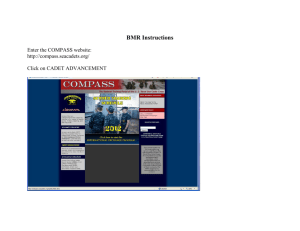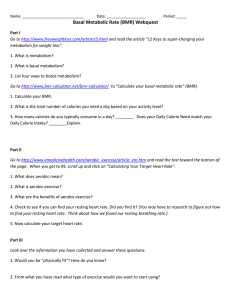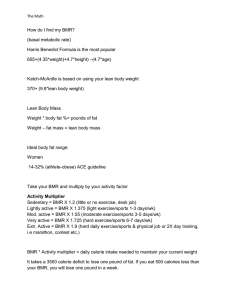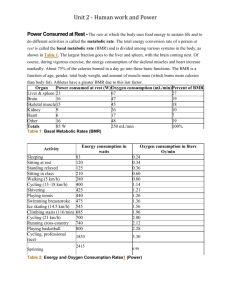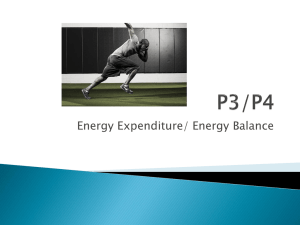8 Energy Balance, Body Composition, and Weight Management
advertisement
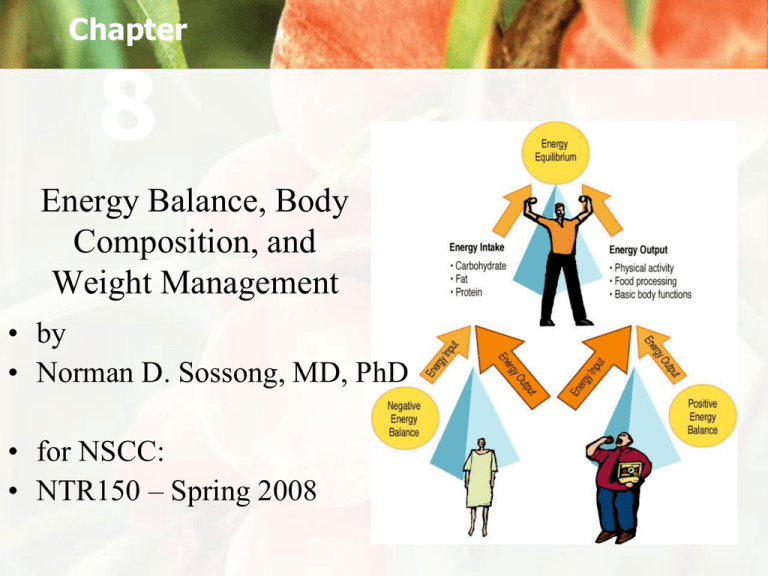
Chapter 8 Energy Balance, Body Composition, and Weight Management • by • Norman D. Sossong, MD, PhD • for NSCC: • NTR150 – Spring 2008 Energy Balance • Energy balance = the balance in the body between the amount of energy consumed and expended • Energy intake = the caloric or energy content of food provided by the sources of dietary energy: carbohydrates (4 kcal/g), fats (9 kcal/g), proteins (4 kcal/g), and alcohol (7 kcal/g) • Energy output = the use of calories or energy for basic body functions, physical activity, and processing of consumed foods Energy Balance • Energy equilibrium = a balance of energy intake and output that results in little or no change in weight over time • Positive energy balance = energy intake exceeds energy expenditure, resulting in an increase in body energy stores and weight gain • Negative energy balance = energy intake is lower than energy expenditure, resulting in a depletion of body stores and weight loss Energy In • Regulation of intake • Hunger • Prompts eating; physiological desire • Satiation • Signals to stop eating • Satiety • Lack of hunger • Appetite • Psychological desire Energy In: Regulatory Factors Energy Out: Fuel Uses • Major components of energy expenditure • Resting energy expenditure (REE) • = Basal energy expenditure (BEE) • Energy for basic body functions • Affected by body size, composition, age, gender • Physical activity • Highly variable • Affected by body size, fitness level, type of activity • Thermic effect of food (TEF) • Energy to digest, absorb, metabolize food Energy Expenditure at Rest Constitutes 60-75% of total energy expenditure Measured as: Basal Metabolic Rate (BMR) = resting metabolic rate (RMR) Conditions: Lying at rest Just awoke from normal sleep 10-12 hours since last meal No physical activity in the past 12-18 hours Note: technically the RMR only requires a 3 to 4 hour waiting period after food or exercise to do the test Result: the RMR is slightly higher than the BMR Factors that Affect Basal Metabolic Rate (BMR) Lean body mass = the body mass (other than fat) = muscles and organ tissue Generally, lean body mass has more metabolism than fat; hence it contributes more to the BMR Factors that Affect Basal Metabolic Rate (BMR) Muscle & organ mass Liver Brain Muscles (resting) Heart Kidney The rest 29% 19% 18% 10% 7% 17% 100% Factors that Affect Basal Metabolic Rate (BMR) Age 2-3% per decade Lean body mass Body fat Organ function Keeping physically active Slows loss of lean body mass Slows gain of fat → preservation of BMR Factors that Affect Basal Metabolic Rate (BMR) Gender: BMR of ♀ < ♂ ♀ (female): smaller less lean body mass Menstrual cycle influences: Low point: a week before ovulation High point: Just before menstruation starts Factors that Affect Basal Metabolic Rate (BMR) • Sleep • 10% ↓ in BMR • ↑ lean body mass → ↑ BMR • (growth spurts, e.g. infancy & adolescence) • Hormones • Thyroid • Norepinephrine • Physical stress Factors that Affect Basal Metabolic Rate (BMR) • Fever • Environmental temperature • Cold • Hot • Mild ↑ • Much ↑ • Starvation • Genetics Energy Used in Various Activities 15-30% of BMR Energy Used to Process Food = Thermic Effect of Food (TEF) = 10% Peaks about 1 hour after eating Usually gone within 5 hours of eating Energy Balance Estimating Energy Expenditure • EER: Estimated Energy Requirement • Predicts total energy expenditure (TEE) • Equations for males and females • Factors for age, weight, height, physical activity • Males: • EER = 662 – 9.53 x Age (yrs) + PA x [15.91 x Wt (kg) + 539.6 x Ht (m)] • PA = 1.0 Sedentary • 1.12 Low active • 1.25 Active • 1.48 Very active Estimating Energy Expenditure • EER: Estimated Energy Requirement • Predicts total energy expenditure (TEE) • Equations for males and females • Factors for age, weight, height, physical activity • Females: • EER = 354 – 6.91 x Age (yrs) + PA x [9.36 x Wt (kg) + 726 x Ht (m)] • PA = 1.0 Sedentary • 1.12 Low active • 1.27 Active • 1.45 Very active Body Composition: Understanding Fatness and Weight • Assessing body weight • Height-weight tables • Body mass index (BMI) • Weight (kg) height2 (m) • Assessing body fatness • Body fat distribution • Waist circumference BMI vs Mortality Waist Circumference • If BMI = 25 – 34.9 kg/m2 • Then waist circumference • > 40 inches in men • or • > 35 inches in women • is a sign of increased health risk When Energy Balance Goes Awry • What are the health risks associated with being overweight? Risks of Being Overweight When Energy Balance Goes Awry • Early theories of weight regulation • Fat cell theory • Set point theory • Influences on weight gain and obesity • • • • • • Heredity and genetic factors Sociocultural influences Age and lifestyle factors Gender and ethnicity Socioeconomic factors Psychological factors Sociocultural Influences on Obesity Gender Biases Regarding Body Shape Weight Management • Perception of weight • Setting realistic goals • Weight management lifestyle • Diet and eating habits • • • • Reduce total calories Reduce fat calories Increase complex carbohydrates Improve eating habits • Increase physical activity • Stress management • Self-acceptance Weight Management • Weight management approaches • Self-help books and manuals • Watch for signs of a fad diet • • • • • Self-help groups Commercial programs Professional counselors Prescription drugs OTC drugs and dietary supplements Weight Management • Weight management approaches • Surgery Underweight • Definition • BMI < 18.5 kg/m2 • Causes • Illness • Eating disorders • Metabolic factors • Weight-gain strategies • Small, frequent meals • Fluids between meals • High-calorie foods and beverages

